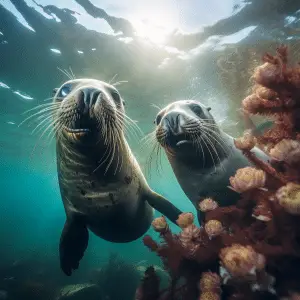Safety must be top priority when encountering underwater wildlife. Familiarize yourself with proper knowledge and techniques. Understand the behavior of species and how to interact respectfully. Follow guidelines and keep a safe distance. This allows for unforgettable interactions, while ensuring the well-being of everyone.
Encounters vary depending on the location and species. Different environments offer unique opportunities. Tropical regions may have colorful coral reefs with vibrant fish. Colder waters may invite majestic mammals like whales or seals.
Familiarize yourself with local regulations and guidelines. Respect wildlife habitats and keep a respectful distance. Observe without disturbing or stressing the animals. Acquire knowledge about specific animal behaviors. Understand signs of aggression or stress. When encountering larger animals, stay calm and avoid sudden movements.
Pro Tip: Consider taking a course on underwater wildlife etiquette and conservation practices. Enhance your understanding of marine ecosystems. Enjoy meaningful and safe interactions with underwater wildlife during your adventures.

Understanding underwater wildlife encounters
Gaining knowledge of marine life is important. Get to know different species, such as sharks, dolphins, turtles, and rays. Learn their habits, feeding patterns, and territories. It’s best to keep a respectful distance and not touch, chase, or harass them.
Be aware of warning signs, like rapid movements, changes in body posture, or vocalizations. Also, stay updated on the latest guidelines from marine conservation organizations on how to interact responsibly with underwater wildlife.
When encountering underwater wildlife, remain calm and use correct equipment. Natural colors for dive suits are best, as they minimize disrupting the environment. This way, divers can enjoy the beauty of the marine world while keeping everyone safe.
Preparing for a safe underwater wildlife encounter
Gather intel! Before beginning your dive, research the area. Learn about the marine life’s habits, behavior, and risks. This will help you decide what to do underwater.
Get the right gear! Get a comfortable wetsuit, mask, snorkel, fins, and gloves. Also, use reef-friendly sunscreen to protect yourself and the environment.
Know the signs! Understand international hand signals for “stay calm,” “stay together,” or “look out”. This will help you communicate with your diving buddies and keep disturbance to a minimum.
Stay back! Respect the wildlife’s boundaries and don’t get too close. They may interpret your approach as a threat.
Look out! Every dive is unique. Follow safety guidelines and local advice. Keep safety a priority and have an unforgettable experience!
Safety guidelines during underwater wildlife encounters
Underwater wildlife encounters can be thrilling! But, safety is essential. Here are guidelines for safe encounters:
- Calmly stay away from animals. Approach slowly and don’t startle them.
- Respectfully observe and never touch creatures. They are wild.
- Be aware and watch out for signs of aggression. If so, back away.
- Don’t feed them. It disrupts their natural habits.
- Don’t litter in water. It harms marine life.
These safety measures protect both divers and wildlife, allowing for enjoyable encounters. Different species have specific regulations. Get familiar with local ones before diving.
Fun Fact! NOAA has developed “Dive into Safety” guidelines for interacting with marine life during underwater encounters.
Communication techniques during encounters
Utilize non-verbal communication in the form of hand signals and body language to effectively convey messages under the waves. Underwater wildlife encounters, For example, a calm posture can show non-aggressive intent.
Maintain eye contact with creatures to form trust and display positive feelings. But, be careful not to look too much into the eyes of potentially threatening animals, as this may be taken as a challenge.
Give marine life plenty of space. Do not attempt to touch or chase them. This will make them feel safe and comfortable in their natural environment.
Speak softly and carefully, avoiding sudden or loud noises that could startle or stress them. Use gentle tones to communicate peacefully without causing alarm.
Study the behavior patterns of species before coming into contact with them. This will help you anticipate their actions, helping with better communication.
Remember that each encounter is unique – observe and respect the boundaries of these creatures to promote an atmosphere of mutual understanding.
Professional guidance or training is advised for effective communication underwater.
Handling unexpected situations
Keep your cool! Don’t make sudden movements. Make sure you stay a safe distance away from marine life. When diving, use signals to communicate with your partner. Prepare for potential emergencies– like getting split from the group. Be conscious of your environment and don’t disturb habitats. Learn rules and accepted practices for interacting with wildlife in the area.
Moreover, it’s essential to be aware of regional details. Things like nearby currents, visibility, and species behavior are important to consider in unexpected situations. Being informed and ready to adapt will guarantee a better and safer diving experience.
Pro Tip: Always take an emergency whistle or signaling device when diving. It can be useful for getting attention or sending out distress messages.
Post-encounter practices
It’s important to follow proper post-encounter practices after meeting underwater wildlife. This ensures safety for both the creature and the individual. Let’s have a look at these practices:
| Practice | ✓ |
|---|---|
| Stay Calm | ✓ |
| Give Respectful Distance | ✓ |
| Observe Behaviors | ✓ |
- Staying calm is key. Panicking can lead to unpredictable reactions from the creature, putting both parties in danger. Keeping calm will ensure the encounter goes well.
- Giving respectful distance is essential. Too close and you could disrupt the creature’s natural habitat or trigger defensive responses that can harm you.
- Observe their behaviors. This gives you an insight into their needs and preferences, so you can respond appropriately without harming them.
Here’s an example of proper post-encounter practices: a diver encountered a manta ray in its natural environment. Although it was overwhelming, they stayed calm and kept a respectful distance. Through patience and observation, they were able to witness the manta ray gracefully gliding through the water.
By following post-encounter practices, individuals can safely interact with and appreciate underwater wildlife, and create a connection between humans and the marine world.
 Conclusion
Conclusion
We looked into strategies for safe underwater wildlife encounters. Stay calm, be respectful and understand we are guests. It is vital to know species behavior and potential risks. Educate yourself first!
Also, environmental factors can affect interactions so be aware of seasonal patterns, mating seasons and feeding grounds.
A diver encountered a turtle on a coral reef. She forgot its personal space and the turtle swam away. She was left filled with regret at disturbing its tranquility.
Frequently Asked Questions
Q: What precautions should I take when encountering underwater wildlife?
A: When encountering underwater wildlife, it is important to remain calm, maintain a safe distance, and avoid any sudden or aggressive movements. Always approach them with caution and respect their space.
Q: Should I touch or feed underwater wildlife?
A: No, it is strongly advised not to touch or feed underwater wildlife. It can disrupt their natural behavior, cause them stress, and may even be dangerous for both the animals and humans.
Q: How can I ensure my safety during encounters with larger marine animals?
A: To ensure your safety during encounters with larger marine animals, such as sharks or whales, it is crucial to stay calm, avoid sudden movements, and maintain a safe distance from them. Keeping eye contact without staring directly into their eyes is also recommended.
Q: Are there any specific guidelines to follow when encountering sea turtles or dolphins?
A: Yes, there are specific guidelines to follow when encountering sea turtles or dolphins. It is recommended to maintain a distance of at least 50 feet (15 meters) from sea turtles and 100 feet (30 meters) from dolphins. Avoid swimming directly above them or obstructing their path.
Q: What do I do if I encounter a potentially dangerous marine animal?
A: If you encounter a potentially dangerous marine animal, such as a venomous or aggressive species, it is essential to stay calm, avoid any sudden movements, and slowly back away to reach a safe distance. Always follow the instructions of trained professionals if present.
Q: What should I do if I accidentally touch a harmful marine creature?
A: If you accidentally touch a harmful marine creature, such as a jellyfish or stingray, it is important to seek medical attention immediately. Rinse the affected area with saltwater and carefully remove any visible tentacles or spines to minimize further damage.
